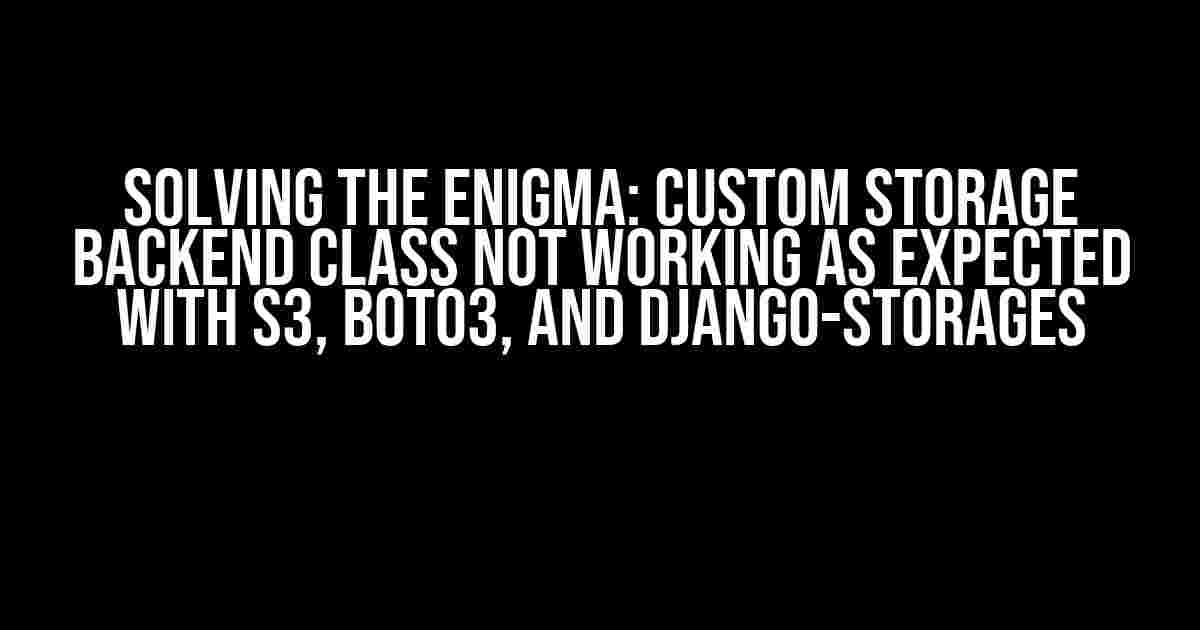Are you tired of scratching your head, trying to figure out why your custom storage backend class isn’t working as expected with S3, boto3, and django-storages? You’re not alone! In this article, we’ll dive into the depths of this issue, explore common pitfalls, and provide a step-by-step guide to get your custom storage backend class up and running in no time.
Understanding the Players: S3, Boto3, and Django-Storages
Before we dive into the solution, let’s take a quick look at the key players involved:
- S3 (Simple Storage Service): Amazon’s cloud-based object storage service, providing scalable and durable storage for your files.
- Boto3: A Python SDK for AWS, allowing you to interact with AWS services, including S3, programmatically.
- Django-Storages: A Django library that provides a simple, flexible way to use different storage backends, including S3, for your project.
The Problem: Custom Storage Backend Class Not Working as Expected
When using django-storages with S3 and boto3, you might encounter issues with your custom storage backend class not working as expected. This can manifest in various ways, such as:
- Files not being uploaded to S3 as expected
- Files being uploaded, but with incorrect permissions or metadata
- Files not being served correctly from S3
- Error messages or exceptions being thrown
Common Pitfalls and Causes
Before we dive into the solution, let’s identify some common pitfalls and causes that might be contributing to the issue:
- Incorrect configuration: Misconfigured settings in your Django project or boto3 client can lead to issues.
- Outdated dependencies: Using outdated versions of boto3, django-storages, or other dependencies can cause compatibility issues.
- Incorrect credentials: Invalid or outdated AWS credentials can prevent your custom storage backend class from working correctly.
- Overriding default settings: Overriding default settings in django-storages or boto3 can lead to unintended consequences.
Solution: Step-by-Step Guide to Creating a Custom Storage Backend Class
Now that we’ve identified the common pitfalls, let’s create a custom storage backend class that works seamlessly with S3, boto3, and django-storages. Follow these steps:
Step 1: Install Required Dependencies
Make sure you have the required dependencies installed:
pip install boto3 django-storages
Step 2: Create a Custom Storage Backend Class
Create a new Python file, e.g., `custom_storage.py`, and add the following code:
import os
from storages.backends.s3boto3 import S3Boto3Storage
class CustomS3Storage(S3Boto3Storage):
location = 'media'
bucket_name = 'your-bucket-name'
def _save(self, name, content):
# Customize the upload process as needed
return super()._save(name, content)
Step 3: Configure Django-Storages and Boto3
In your Django project’s `settings.py` file, add the following configurations:
AWS_ACCESS_KEY_ID = 'YOUR_AWS_ACCESS_KEY_ID' AWS_SECRET_ACCESS_KEY = 'YOUR_AWS_SECRET_ACCESS_KEY' AWS_STORAGE_BUCKET_NAME = 'your-bucket-name' DEFAULT_FILE_STORAGE = 'path.to.custom_storage.CustomS3Storage'
Step 4: Override Default Settings (Optional)
If needed, you can override default settings in django-storages or boto3. For example:
AWS_S3_FILE_OVERWRITE = False AWS_S3_MAX_MEMORY_SIZE = 1048576
Step 5: Test Your Custom Storage Backend Class
Run the following code to test your custom storage backend class:
from django.core.files.storage import default_storage
file = default_storage.open('test.txt', 'w')
file.write('Hello, world!')
file.close()
print('File uploaded successfully:')
print(default_storage.url('test.txt'))
Troubleshooting and Optimizations
If you’re still experiencing issues or want to optimize your custom storage backend class, consider the following:
- Enable debugging: Set `AWS_S3_DEBUG = True` in your Django project’s `settings.py` file to enable debugging for boto3.
- Use a separate S3 bucket for development: Create a separate S3 bucket for development to avoid affecting your production storage.
- Optimize storage settings: Adjust storage settings, such as `AWS_S3_MAX_MEMORY_SIZE`, to optimize performance.
- Implement caching: Implement caching using django-storages’ built-in caching or third-party caching libraries.
Conclusion
With these steps, you should now have a custom storage backend class that works seamlessly with S3, boto3, and django-storages. Remember to double-check your configurations, dependencies, and code to avoid common pitfalls. By following this guide, you’ll be able to efficiently store and serve files in your Django project using a custom storage backend class.
| Dependency | Version | Description |
|---|---|---|
| boto3 | 1.17.10 | AWS SDK for Python |
| django-storages | 1.12.3 | Django library for working with storage backends |
| Django | 3.2.5 | Python web framework |
Happy coding!
Frequently Asked Question
Stuck with custom storage-backend class not working as expected with S3, boto3, and django-storages? We’ve got you covered!
Why isn’t my custom storage-backend class being recognized by Django?
Make sure you’ve defined your custom storage class in the `DEFAULT_FILE_STORAGE` setting in your Django project’s settings file. Also, double-check that the class is properly imported and instantiated in your storage configuration.
How do I troubleshoot issues with my custom storage-backend class?
Enable debug logging by setting `DEBUG=True` in your Django project’s settings file. This will provide more detailed error messages. You can also use tools like `pdb` or `ipdb` to set breakpoints and inspect the code execution.
Why am I getting a ` botocore.errorfactory.NoSuchBucket` error?
This error typically occurs when the specified S3 bucket does not exist or the AWS credentials used do not have access to the bucket. Verify that the bucket exists and your AWS credentials are correct. Also, ensure that the bucket name is correctly specified in your `AWS_STORAGE_BUCKET_NAME` setting.
Can I use a custom storage-backend class with a non-S3 storage backend?
Yes, you can! Django-storages supports multiple storage backends, including local file storage, Azure Blob Storage, and more. You can write a custom storage-backend class to work with any storage backend that django-storages supports.
How do I handle file upload and download operations using my custom storage-backend class?
You’ll need to override the `save()` and `open()` methods of your custom storage-backend class to handle file upload and download operations respectively. You can also use the `storages` library’s built-in methods, such as `_save()` and `_open()`, to simplify the process.

